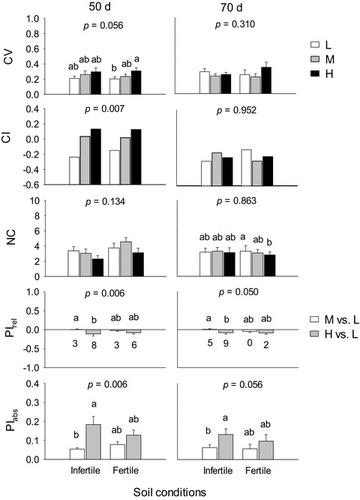当前位置:
X-MOL 学术
›
Ecol. Evol.
›
论文详情
Our official English website, www.x-mol.net, welcomes your
feedback! (Note: you will need to create a separate account there.)
Morphological canalization, integration, and plasticity in response to population density in Abutilon theophrasti: Influences of soil conditions and growth stages
Ecology and Evolution ( IF 2.3 ) Pub Date : 2021-07-28 , DOI: 10.1002/ece3.7960 Shu Wang 1 , Dao-Wei Zhou 2
Ecology and Evolution ( IF 2.3 ) Pub Date : 2021-07-28 , DOI: 10.1002/ece3.7960 Shu Wang 1 , Dao-Wei Zhou 2
Affiliation

|
Phenotypic integration and developmental canalization have been hypothesized to constrain the degree of phenotypic plasticity, but little evidence exists, probably due to the lack of studies on the relationships among the three processes, especially for plants under different environments. We conducted a field experiment by subjecting plants of Abutilon theophrasti to three densities, under infertile and fertile soil conditions, and analyzing correlations among canalization, integration, and plasticity in a variety of measured morphological traits after 50 and 70 days, to investigate the relationships among the three variables in response to density and how these responses vary with soil conditions and growth stages. Results showed trait canalization decreased and phenotypic integration and the degree of plasticity (absolute plasticity) in traits increased with density. Phenotypic integration often positively correlated with absolute plasticity, whereas correlations between trait canalization and plasticity were insignificant in most cases, with a few positive ones between canalization and absolute plasticity at low and medium densities. As plants grew, these correlations intensified in infertile soil and attenuated in fertile soil. Our findings suggested the complexity of the relationship between canalization and plasticity: Decreased canalization is more likely to facilitate active plastic responses under more favorable conditions, whereas increased level of integration should mainly be an outcome of plastic responses. Soil conditions and growth stage may affect responses of these correlations to density via modifying plant size, competition strength, and plastic responses in traits. We also predicted that decreased canalization can be advantageous or disadvantageous, and the lack of response to stress may demonstrate a stronger ability of adaptation than passive response, thus should be adaptive plasticity as active response.
中文翻译:

苘麻种群密度的形态渠道化、整合和可塑性:土壤条件和生长阶段的影响
人们假设表型整合和发育通道化限制了表型可塑性的程度,但证据很少,可能是由于缺乏对这三个过程之间关系的研究,特别是对于不同环境下的植物。我们通过田间试验,将苘麻植株在贫瘠和肥沃的土壤条件下置于三种密度下,50天和70天后,分析多种测量形态性状的渠化性、整合性和可塑性之间的相关性,以探讨它们之间的关系。三个变量对密度的响应以及这些响应如何随土壤条件和生长阶段而变化。结果表明,性状管道化减少,表型整合和性状可塑性程度(绝对可塑性)随着密度的增加而增加。表型整合通常与绝对可塑性呈正相关,而性状管道化与可塑性之间的相关性在大多数情况下并不显着,在低和中等密度下,管道化与绝对可塑性之间也有一些正相关。随着植物的生长,这些相关性在贫瘠的土壤中增强,而在肥沃的土壤中减弱。我们的研究结果表明了渠道化和可塑性之间关系的复杂性:渠道化的减少更有可能在更有利的条件下促进活跃的塑性反应,而整合水平的提高应该主要是塑性反应的结果。土壤条件和生长阶段可能通过改变植物大小、竞争强度和性状的可塑性反应来影响这些相关性对密度的反应。 我们还预测,渠道化的减少可能是有利的,也可能是不利的,对压力缺乏反应可能表现出比被动反应更强的适应能力,因此应该是适应性可塑性作为主动反应。
更新日期:2021-09-09
中文翻译:

苘麻种群密度的形态渠道化、整合和可塑性:土壤条件和生长阶段的影响
人们假设表型整合和发育通道化限制了表型可塑性的程度,但证据很少,可能是由于缺乏对这三个过程之间关系的研究,特别是对于不同环境下的植物。我们通过田间试验,将苘麻植株在贫瘠和肥沃的土壤条件下置于三种密度下,50天和70天后,分析多种测量形态性状的渠化性、整合性和可塑性之间的相关性,以探讨它们之间的关系。三个变量对密度的响应以及这些响应如何随土壤条件和生长阶段而变化。结果表明,性状管道化减少,表型整合和性状可塑性程度(绝对可塑性)随着密度的增加而增加。表型整合通常与绝对可塑性呈正相关,而性状管道化与可塑性之间的相关性在大多数情况下并不显着,在低和中等密度下,管道化与绝对可塑性之间也有一些正相关。随着植物的生长,这些相关性在贫瘠的土壤中增强,而在肥沃的土壤中减弱。我们的研究结果表明了渠道化和可塑性之间关系的复杂性:渠道化的减少更有可能在更有利的条件下促进活跃的塑性反应,而整合水平的提高应该主要是塑性反应的结果。土壤条件和生长阶段可能通过改变植物大小、竞争强度和性状的可塑性反应来影响这些相关性对密度的反应。 我们还预测,渠道化的减少可能是有利的,也可能是不利的,对压力缺乏反应可能表现出比被动反应更强的适应能力,因此应该是适应性可塑性作为主动反应。










































 京公网安备 11010802027423号
京公网安备 11010802027423号